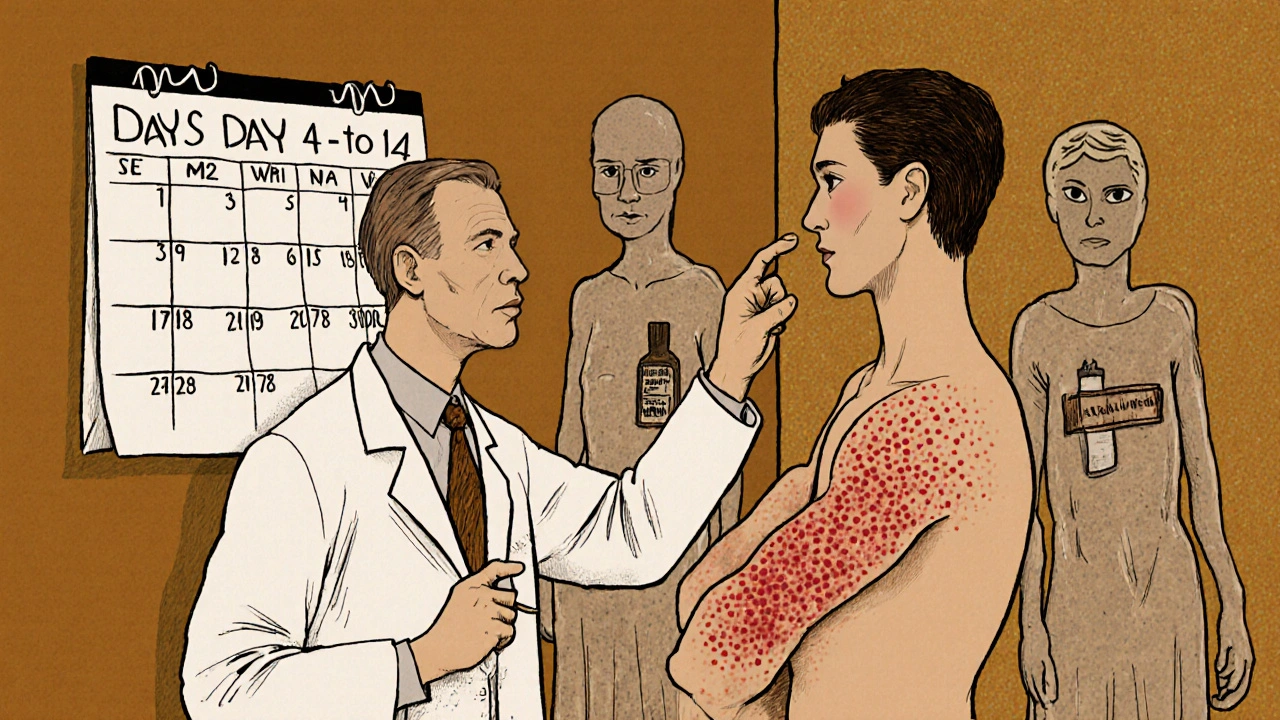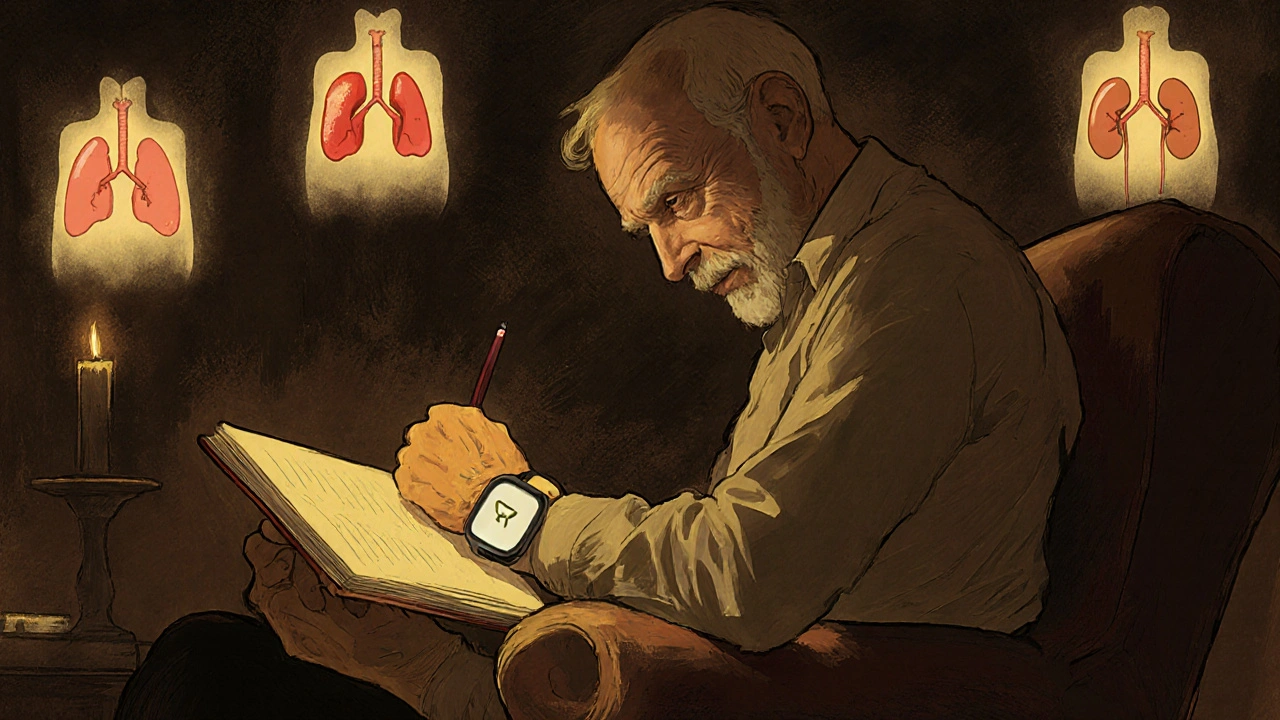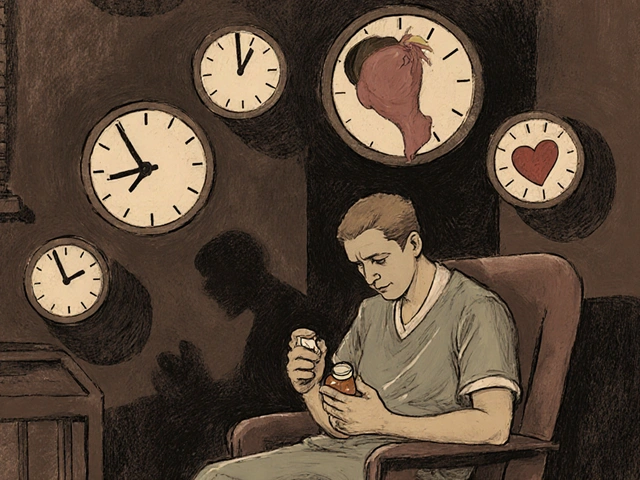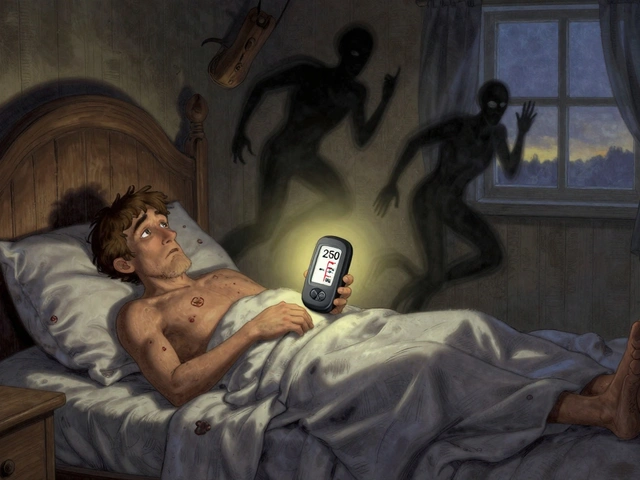Medication Side Effect Timeline Calculator
Find out when medication side effects might appear based on your specific drug and personal factors. This tool helps you recognize when to watch for symptoms and when to seek medical attention.
Starting a new medication can feel like stepping into the dark. You know it’s supposed to help, but what if something goes wrong? And when exactly should you start worrying? The truth is, medication side effects don’t all show up at the same time. Some hit you within minutes. Others creep in weeks later. Knowing when to expect what can turn panic into awareness - and maybe even save your life.
Immediate Reactions: Minutes to One Hour
If you feel dizzy, your throat starts closing, or your skin breaks out in hives right after swallowing a pill, don’t wait. These are signs of an immediate reaction - and they need urgent attention. Anaphylaxis, the most dangerous type, happens in under an hour in nearly all cases. Studies show 67% of these reactions begin within 15 minutes of taking the drug. Penicillin is a classic trigger: 73% of allergic reactions to it show up within 15 minutes. Other immediate reactions include sudden wheezing, rapid heartbeat, or swelling around the eyes and lips.
These reactions are usually allergic - your immune system mistakes the drug for a threat and goes into overdrive. Even if you’ve taken the same medicine before without issue, you can still develop an allergy suddenly. That’s why doctors always ask you to wait in the clinic after your first dose of certain antibiotics or vaccines. It’s not bureaucracy - it’s safety.
Early Delayed Reactions: 1 to 72 Hours
Not all side effects scream for help right away. Many show up between one and three days later. This window covers a lot of common but less urgent reactions. Think nausea, headaches, drowsiness, or a mild rash. These aren’t always allergies. Sometimes they’re just your body adjusting to the new chemical.
For example, if you start a new antibiotic like amoxicillin, you might notice a rash on day two or three. That’s often a non-allergic reaction, not a true allergy. About 89% of mild drug allergy symptoms fall into this 1- to 72-hour window. The same goes for some types of drug-induced liver inflammation or fever that mimics a virus.
Here’s the catch: if you feel worse instead of better after a few days, don’t assume it’s just "getting used to it." Keep track. A rash that spreads? Fever that doesn’t break? That’s your body saying something’s off. Call your doctor - don’t wait for it to get worse.
Delayed Reactions: 4 Days to 8 Weeks
This is where things get tricky. Many side effects don’t appear until you’ve been taking the medicine for days or weeks. That’s because the drug is slowly building up in your system. Or your immune system is slowly turning against it.
One of the most common delayed reactions is a maculopapular rash - flat red patches with small bumps. It shows up in 68% of cases between days 4 and 14. Antibiotics, antivirals, and seizure medications like carbamazepine are frequent culprits. The median onset? Day 8. That means if you’ve been on the drug for a week and suddenly feel itchy or see red spots, it’s likely connected.
Even more serious is DRESS syndrome - Drug Reaction with Eosinophilia and Systemic Symptoms. It’s rare, affecting about 1 in 1,000 people on certain drugs. But it’s dangerous. Symptoms include high fever, swollen lymph nodes, and organ inflammation. The median time to onset? 28 days. That’s nearly four weeks. If you’re on an anticonvulsant or allopurinol and suddenly feel sick weeks in, don’t brush it off. DRESS can be fatal if not caught early.
Antidepressants fall into this category too. You might not feel better for weeks - but side effects like nausea, insomnia, or emotional numbness often show up within 10 to 21 days. That’s why follow-ups at two and four weeks are standard. Your doctor isn’t just checking if it’s working - they’re watching for hidden side effects you might not even notice yourself.

Chronic Reactions: Beyond 8 Weeks
Some side effects take months to show up. These aren’t accidents. They’re the result of long-term exposure. Statins, for example, can cause muscle pain or weakness within 7 to 10 days for some people. But for others, it takes months. Amiodarone, a heart rhythm drug, can cause lung damage after six to twelve months of use. You might just feel tired or out of breath - and blame it on aging or stress.
Drug-induced lupus is another slow burner. It mimics the autoimmune disease lupus, causing joint pain, rashes, and fatigue. It can take months or even years to develop. The good news? It usually goes away once you stop the drug. But if you don’t connect the dots, you could end up with unnecessary tests and treatments.
And then there are medications that affect your bones, liver, or kidneys over time. Metformin, for example, rarely causes problems - but in people with kidney issues, it can build up and lead to lactic acidosis after months of use. That’s why regular blood tests are part of the deal for long-term prescriptions.
What Changes the Timeline?
Two people take the same pill. One feels fine. The other gets sick the next day. Why? Because timing isn’t just about the drug - it’s about you.
Age matters. People over 65 process drugs slower. Side effects show up about 2.3 days later on average than in younger adults.
Kidney or liver function? If your body can’t clear the drug efficiently, it lingers longer. That means side effects stick around longer - or show up later than expected.
Genetics. Some people carry a gene called HLA-B*57:01. If you have it and take abacavir (an HIV drug), you’re almost guaranteed a severe reaction - and it’ll hit within 48 hours. Genetic testing is now standard before prescribing this drug for that exact reason.
Dosage. Higher doses mean faster reactions. If you’re on a high dose of a new medication, side effects are more likely to appear within 24 hours. At normal doses? It could take days.
Other conditions. If you have an autoimmune disease, your immune system is already on high alert. That means you’re more likely to react to a drug - and faster. Studies show these patients develop side effects 37% quicker than others.

What Should You Do?
Knowing when side effects might show up isn’t about scaring you. It’s about empowering you.
- First week: Watch for anything unusual. Headache? Nausea? Rash? Write it down - including the time and what you were doing.
- Days 4 to 14: This is the danger zone for rashes and flu-like symptoms. Don’t ignore them.
- Weeks 3 to 8: If you’re on antidepressants, anticonvulsants, or antivirals, be extra alert. This is when the big ones like DRESS can appear.
- After 8 weeks: Keep an eye out for fatigue, shortness of breath, or joint pain. These could be signs of long-term damage.
Keep a simple symptom journal. Note the date, time, what you took, and how you felt. A 2021 study found that patients who did this were far more likely to correctly identify medication side effects than those who didn’t. Sixty-three percent got it right - compared to just 29% who didn’t track anything.
If you think you’re having a reaction, don’t stop the drug unless it’s life-threatening. Call your doctor. Some side effects fade as your body adjusts. Others need immediate action. Only a professional can tell the difference.
And if you’re switching from brand-name to generic? Be careful. Even if the active ingredient is the same, the fillers and coatings can differ. One study found 23% of patients noticed side effects changed when they switched - sometimes showing up sooner or later than expected.
What’s New in Predicting Side Effects?
Doctors aren’t guessing anymore. New tools are making side effect timing more predictable.
Mayo Clinic’s personalized medicine program now uses a computer model that looks at 12 factors - your age, genetics, kidney function, and more - to predict when you’re likely to have a reaction. It’s 84% accurate.
AI platforms like IBM Watson are analyzing over a million past adverse event reports to spot patterns. They can now predict when a side effect will appear with nearly 80% accuracy - but right now, only a small fraction of clinics have access.
And then there are apps. People who use medication trackers with side effect logging have 32% fewer emergency visits for drug reactions. That’s not magic. It’s awareness.
The future? Wearables that monitor your heart rate, temperature, and oxygen levels in real time - combined with your genetic profile. That’s how we’ll catch side effects before they become problems.
Right now, the best tool you have is knowledge. Know your timeline. Track your symptoms. Talk to your doctor. Your body is trying to tell you something. Learn to listen.







gina rodriguez
Thanks for laying this out so clearly. I started a new antibiotic last week and was freaked out by a tiny rash on day 5-now I know it’s probably normal, but I’m still keeping a journal just in case. Good reminder to not panic too fast.
Sue Barnes
Anyone else notice how doctors act like they’re giving you a magic wand when they hand you a prescription? No one tells you half this stuff. You’re supposed to just ‘trust the process’ while your body turns into a science experiment. Wake up.
jobin joshua
Bro this is 🔥 I was on carbamazepine for 3 weeks and got a rash on day 9 😳 turned out it was DRESS. I thought it was just allergies. Don’t ignore it. Your life > your pride.
Sachin Agnihotri
Wow, this is actually super helpful-I’ve been on metformin for a year and never realized that fatigue could be tied to it, not just ‘getting older.’ I’m gonna start tracking my symptoms now. Thanks for sharing the science behind it!
Diana Askew
They don’t want you to know this… but Big Pharma *wants* you to get sick slowly so you stay on meds longer. That’s why they hide the 8-week reactions. Read the fine print. It’s all in the patents.
King Property
Let’s be real-most people can’t even spell ‘anaphylaxis,’ let alone recognize it. That’s why 80% of ER visits for drug reactions are preventable. If you’re too lazy to read the pamphlet, don’t blame the doctor when your tongue swells. You were warned.
Yash Hemrajani
Oh cool, so now we’re supposed to become amateur pharmacologists just to take a pill? 🤡 I’ve been on antidepressants for 6 months and still don’t know if my insomnia is from the drug or my ex texting me at 2am. Either way, thanks for the extra stress.
Pawittar Singh
You got this! 🙌 I know it’s scary, but tracking symptoms? That’s power. I used to ignore every weird feeling-now I write it down, call my doc, and feel way less alone. You’re not crazy, you’re just paying attention. Keep going 💪
Josh Evans
My grandma switched from brand to generic lisinopril and started getting dizzy two days later. We thought it was her blood pressure, but it was the filler. Never thought about that. Thanks for mentioning it.
Allison Reed
This is one of the most thoughtful, well-researched pieces I’ve read on medication safety. The timeline breakdown is invaluable, and the emphasis on journaling is spot-on. Thank you for making complex medical info accessible without dumbing it down.
Jacob Keil
So… like… if time is an illusion and we’re all just energy vibrating… then is a side effect really a ‘reaction’ or just… your soul resisting the corporate chemical matrix? 🤯
Rosy Wilkens
Did you know the FDA only requires testing for 6 months? Six months! That’s less than the lifespan of a fruit fly. How can you possibly know if a drug is safe for lifelong use? This isn’t medicine-it’s a gamble with your DNA.
Andrea Jones
Fun fact: I once thought my ‘mild headache’ from amoxicillin was just stress… turned out it was a delayed allergic reaction. I’m now the queen of symptom journals. You’re not being dramatic-you’re being smart. Keep track. Always.
Justina Maynard
They say ‘listen to your body’ like it’s some mystical whisper… but what if your body’s screaming in a language you forgot how to speak? I used to ignore the itching, the nausea, the weird fog-until I started writing it down. Now I see patterns. Now I speak up. Your body’s not broken. It’s trying to translate.